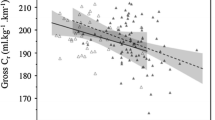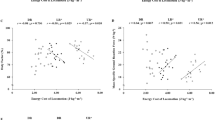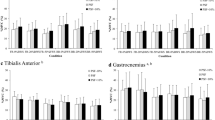Abstract
The present study was designed to investigate how much running economy would be affected by changing the placement of extra load on running subjects. Twenty-four volunteer college students, 18 males and 6 females between 19 and 25 years ran on a treadmill at three different speeds (6, 8, and 10 km h−1). Energy expenditure was measured in O2 l min−1. Subjects were tested under three experimental conditions, presented in random order; a normal (baseline) condition, and two different conditions in which the subjects had to carry extra load. The extra load added 10% to the subjects’ body mass, and was placed symmetrically on the subjects’ shoulders or around their waists. Loading of the subjects affected running economy negatively in both conditions but more so for the shoulder condition. It is argued that the difference between the conditions is due to the fact that the subjects’ balance control deteriorated when their centre of gravity was elevated by adding extra load on their shoulders.

Similar content being viewed by others
References
Almåsbakk B, Whiting HTA, Helgerud J (2001) The efficient learner. Biol Cybern 84:75–83
Anderson T (1996) Biomechanics and running economy. Sports Med 22:76–89
Ariens GA, van Mechelen W, Kemper HC, Twisk JW (1997) The longitudinal development of running economy in males and females aged between 13 and 27 years: the Amsterdam Growth and Health Study. Eur J Appl Physiol Occup Physiol 76:214–220
Bassett DR Jr, Howley ET (2000) Limiting factors for maximum oxygen uptake and determinants of endurance performance. Med Sci Sport Exer 32:70–84
Batterham AM, Vanderburgh PM, Mahar MT, Jackson AS (1999) Modeling the influence of body size on VO2peak: effects of model choice and body composition. J Appl Physiol 87:1317–1325
Berg K (2003) Endurance training and performance in runners: research limitations and unanswered questions. Sports Med 33:59–73
Bernstein NA (1996) On dexterity and its development. In: Latash ML, Turvey MT (eds) Dexterity and its development. Erlbaum, Mahwah, pp 1–244
Bernstein NA (1967) The co-ordination and regulation of movements. Pergamon, Oxford
Bobet J, Norman RW (1984) Effects of load placement on back muscle activity in load carriage. Eur J Appl Physiol Occup Physiol 53:71–75
Bransford DR, Howley ET (1976) Oxygen cost of running in trained and untrained men and women. Med Sci Sport Exer 9:41–44
Bunc V, Heller J (1994) Energy cost of running in young and adult female athletes. Ergonomics 37:167–174
Craib MW, Mitchell VA, Fields KB, Cooper TR, Hopewell R, Morgan DW (1996) The association between flexibility and running economy in sub-elite male distance runners. Med Sci Sport Exer 28:737–743
Hong Y, Brueggemann G-P (2000) Changes in gait patterns in 10-year-old boys with increasing loads when walking on a treadmill. Gait Posture 11:254–259
Jakólska A, Goossens P, Veenstra B, Jakólski A, Skinner JS (1999) Comparison of treadmill and cycle ergometer measurements of force–velocity relationships and power output. Int J Sports Med 20:192–197
Jensen K, Johansen L, Karkkainen OP (1999) Economy in track runners and orienteers during path and terrain running. J Sport Sci 17:945–950
Knapik JJ, Reynolds KL, Harman E (2004) Soldier load carriage: historical, physiological, biomechanical, and medical aspects. Mil Med 169:45–56
LaFiandra M, Wagenaar RC, Holt KG, Obusek JP (2003) How do load carriage and walking speed influence trunk coordination and stride parameters? J Biomech 36:87–95
Lejeune TM, Willems PA, Heglund NC (1998) Mechanics and energetics of human locomotion on sand. J Exp Biol 201:2071–2080
Malhotra MS, Sen Gupta J (1965) Carrying of school bags by children. Ergonomics 8:55–60
Morgan DW, Bransford DR, Costill DL, Daniels JT, Howley ET, Krahenbuhl GS (1995) Variation in the aerobic demand of running among trained and untrained subjects. Med Sci Sport Exer 27:404–409
Morgan DW, Daniels JT (1994) Relationship between VO2max and the aerobic demand of running in elite distance runners. Int J Sports Med 15:426–429
Nevill AM, Brown D, Godfrey R, Johnson PJ, Romer L, Stewart AD, Winter EM (2003) Modeling maximum oxygen uptake of elite endurance athletes. Med Sci Sport Exer 35:488–494
Saunders PU, Pyne DB, Telford RD, Hawley JA (2004) Factors affecting running economy in trained distance runners. Sports Med 34:465–485
Sproule J (1998) Running economy deteriorates following 60 min of exercise at 80% VO2max. Eur J Appl Physiol 77:366–371
Stuempfle KJ, Drury DG, Wilson AL (2004) Effect of load position on physiological and perceptual responses during load carriage with an internal frame backpack. Ergonomics 47:784–789
Svedenhag J, Sjödin B (1985) Physiological characteristics of elite male runners in and off-season. Can J Appl Sport Sci 10:127–133
Vanderburgh PM, Flanagan S (2000) The backpack run test: a model for a fair and occupationally relevant military fitness test. Mil Med 165:418–421
Vereijken B, Pedersen AV, Størksen JH (1999) The development of postural control in early independent walking. In: Gantchev N, Gantchev GN (eds) From basic motor control to functional recovery: concepts, theories and models—present state and perspective. Academic Publishing House, Sofia, pp 282–287
Williams TJ, Krahenbuhl GS (1997) Menstrual cyle phase and running economy. Med Sci Sport Exer 29:1609–1618
Winter DA, MacKinnon CD, Ruder GK, Wieman C (1993) An integrated EMG/biomechanical model of upper body balance and posture during human gait. Prog Brain Res 97:359–367
Zavorsky GS, Montgomery DL, Pearsall DJ (1998) Effect of intense interval workouts on running economy using three recovery durations. Eur J Appl Physiol 77:224–230
Author information
Authors and Affiliations
Corresponding author
Rights and permissions
About this article
Cite this article
Pedersen, A.V., Stokke, R. & Mamen, A. Effects of extra load position on energy expenditure in treadmill running. Eur J Appl Physiol 102, 27–31 (2007). https://doi.org/10.1007/s00421-007-0553-1
Accepted:
Published:
Issue Date:
DOI: https://doi.org/10.1007/s00421-007-0553-1




